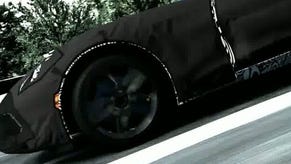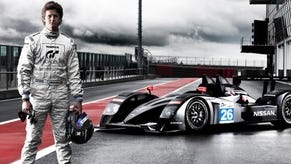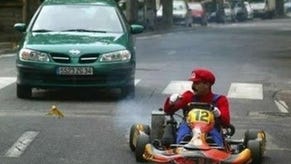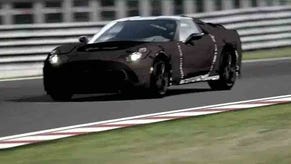Gran Turismo 5 Tech Analysis
Digital Foundry's most comprehensive feature ever.
Woah. This is one of the biggest, most detail-rich tech analyses we've ever put together, but there's little doubt that developer Polyphony Digital is a studio that likes to dwell on the technical details, and to be frank, a release as highly anticipated as Gran Turismo 5 more than deserves the mileage.
In this piece, we've critically appraised the visuals, analysed the game in 720p, 1080p and 3D modes, and put together extensive comparisons that serve to chart Polyphony's technical development in the past 71 months since PS2 epic Gran Turismo 4 was launched in Japan.
In addition to that, GT5 is a game that lovingly revels in technical minutiae - something we obviously appreciate - so we've also covered some of the less important, but still curious additions such as the PlayStation Eye head-tracking. Bearing in mind the significance of this release, and the lengths we had to go to in creating our video assets, we've also made available 720p60 high-quality movie downloads for all our major movies.
There are so many discussion points to cover in a game as vast and as technologically advanced as Gran Turismo 5, and while it's impossible to be completely definitive in the relatively short time we've had with the game, across the following five pages these are the major topics we've looked into. Click to skip straight ahead to what you fancy:
- Framebuffer/Image Quality
- A Generational Leap? Gran Turismo 4 vs. Gran Turismo 5
- The HD Era: Gran Turismo HD/Prologue vs. Gran Turismo 5
- Vehicle Modelling: Standard vs. Premium Cars
- Performance Analysis: 720p vs. 1080p vs. 3D
- Gran Turismo 5: The 3D Experience
- Head-Tracking with PlayStation Eye
- Bonus Goodies: PSP Import and Photo Mode
- Gran Turismo 5: The Digital Foundry Verdict
Framebuffer/Image Quality
Let's kick off the proceedings by taking a look at the physical make-up of the framebuffer. By and large, not a great deal has really changed from the rendering principles laid down by Gran Turismo 5 Prologue. The game still renders at native 720p with 4x multi-sampling anti-aliasing (MSAA) when your XMB is set to 720p mode, while the resolution shifts to 1280x1080 with 2x quincunx (QAA) when the 1080p mode is engaged. So we're not seeing anything like native 1080p resolution here, but you are getting a 50 per cent increase in the number of pixels rendered.
Thin objects and specular highlights such as the sheen on the beautifully rendered cars (one of the most important elements in the game's visual make-up) definitely benefit from the increase in resolution, adding to the precision look of the game. However, up against the 4x MSAA of the 720p mode, the combination of the upscaling from 1280 to 1920 pixels in width, along with the use of quincunx anti-aliasing, does serve to make textures look a touch more blurred.
There is an argument that Polyphony might have considered 720p with 2x MSAA for lowest resolution mode. Running at 60FPS tends to blend things naturally in the human eye any way, and this effect is amplified when everything is in motion, as in a driving game. It may also have increased performance and reduced tearing.
That said, achieving 4x MSAA with frame-rates and details as high as this is indeed a technical achievement unmatched by any of Polyphony's competitors (Forza 3 is 720p with 2x MSAA, for example), and there is a definite feeling that Kazunori Yamauchi's team likes to push boundaries like this.
The 3D mode is an interesting experience, operating at an effective 1280x720's worth of resolution per eye in the familiar top/bottom stacked HDMI 1.4 format. Here we see that the 4x MSAA is gone (presumably for performance and perhaps memory-related reasons) and the 2x QAA of the 1080p mode is installed in its place. There are no other changes made that we can see - you do see slight changes in the lighting between the left and right eyes, but presumably this is down to the different viewpoint between each eye.
Update: There is the option in display settings to choose between Normal, Flicker Reduction and Sharper modes. We suspect these are for optimising the game on a standard def monitor, as comparison shots seem to indicate no difference in 720p, 1080p or 3D modes. Here are some 1080p shots. We tested both in-game and via Replay Theatre, but image quality remained the same regardless of our selections.
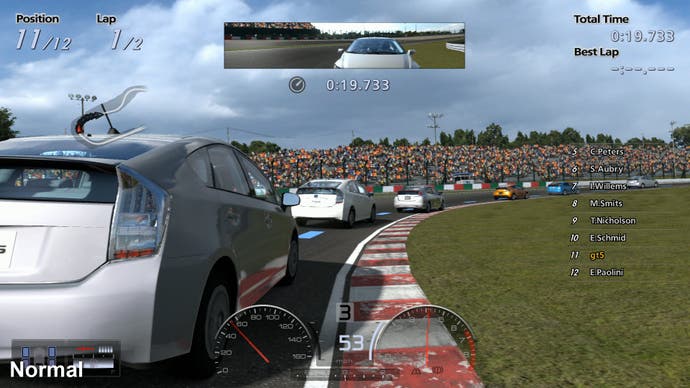
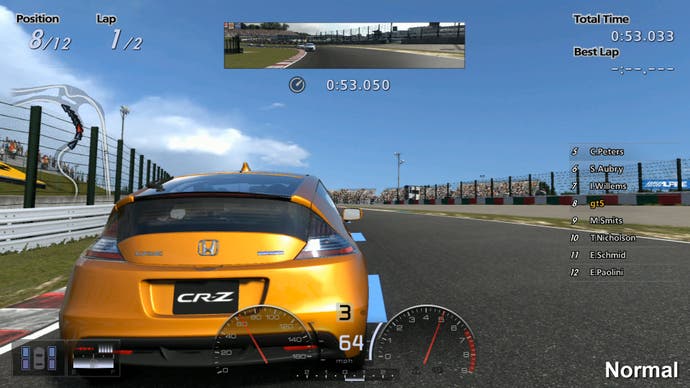

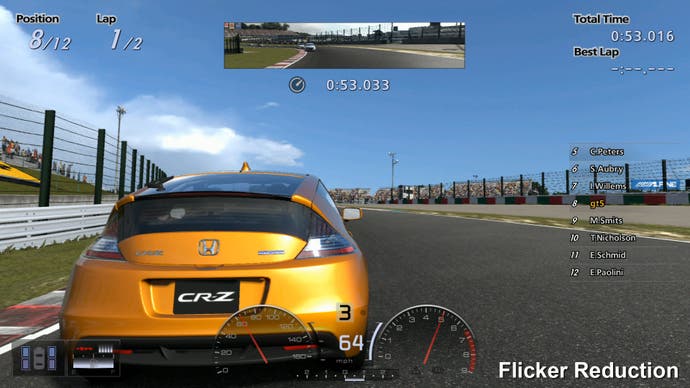
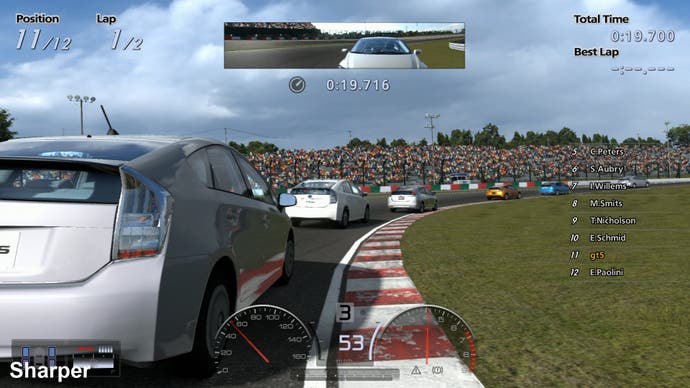
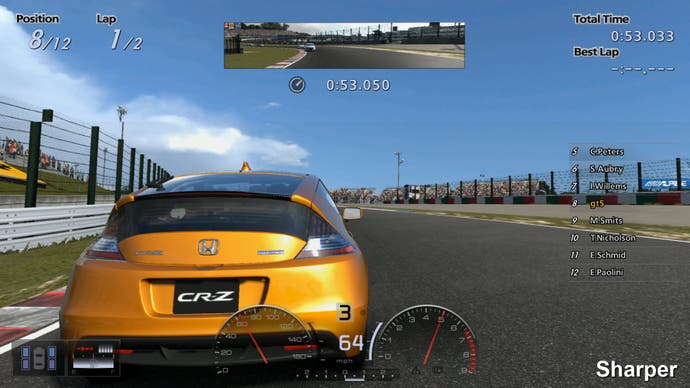
There's little you can fault with the overall presentation of the visuals: there are some absurdly high-quality models for each of the premium-level cars (reputedly allocated a budget of 100,000 polygons for the highest LOD models on the premium cars) and while lighting is basic compared to some of the techniques seen in other racers - Need for Speed: Hot Pursuit's environmentally sampled lighting model is pretty awesome - Polyphony's pristine specular sheen on the cars has an aura of beauty about it, a sense that you're being immersed in a CG-quality world.
Not so impressive is the handling of alpha. Spray in particular on the wet levels looks - to be blunt - pretty dreadful. What we're seeing here is a 1/16th size buffer.
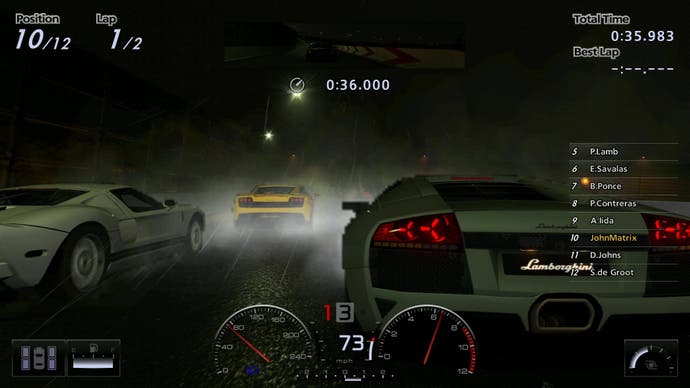

Another area that is seen to be wanting is the implementation of shadows on the cars on some circuits. This didn't seem like as much of an issue in Gran Turismo 5 Prologue, but then again the older game didn't have any real-time weather effects or changing times of day.
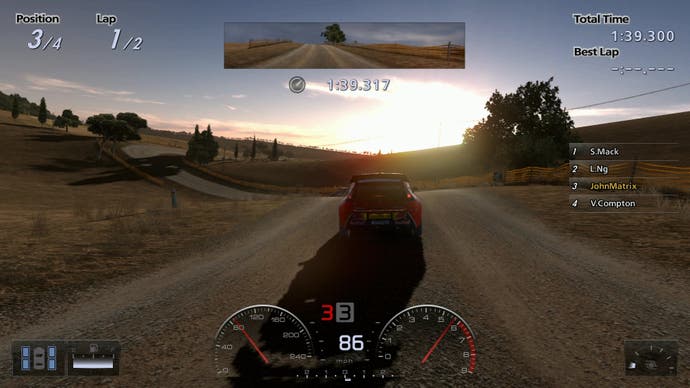

Aside from these ugly elements, the overall pristine look of the game is exemplary, and it's a clear visual leap beyond what was seen in Gran Turismo 4. This is Polyphony Digital's forte of course. Low resolution, 30FPS, clear clipping issues and a need to use one of the lower-quality framebuffer modes made the original GT look pretty abysmal up against the superb-looking Gran Turismo 3. Here we saw much higher resolution, superior modelling, and a doubling of the frame-rate. So do we see a similar leap in rendering quality between GT4 and the latest addition to the series?
A Generational Leap? Gran Turismo 4 vs. Gran Turismo 5
The leap from GT4 to GT5 is all about resolution, lighting, and modelling. There's a clear sense of purpose from Polyphony in delivering what looks like close to photo mode-quality cars within the gameplay experience itself - and more of them too.
To illustrate the visual upgrade, here's a quick comparison movie. Here we take a Mini Cooper-S through the Tokyo R246 city level, and a Lotus Elise 111R around the Clubman Special Stage. There are two clips per circuit where we've attempted to stay in sync as closely as possible. Gran Turismo 4 ran at a relatively meagre 632x448, so the leap to 1280x720, let alone 1280x1080, is vast enough in its own right. Factor in the superior lighting, longer draw distances and more highly refined art and it is clear that GT5 is the generational leap we were hoping for.
However, also note that the modelling of the environments has changed significantly, perhaps for technical as well as artistic reasons. In terms of the actual make-up of the scenes, there are areas where the PS2 game actually features more environmental objects, though of course detail is much more simplistic compared to the new game.
That said, frame-rates on GT4 are undoubtedly higher and tearing, although present, is nowhere near as pronounced as it is in GT5. Crowds seem to be denser in places on PS2; the lower resolution meaning that the models could be far more basic. Additionally, it's worth remembering that the PS2 architecture is a bit of a monster when it comes to fill-rate, plus of course the PS3, operating in 1080p mode, has a pixel count almost 400 per cent higher than its predecessor.
Gran Turismo 5 was released just one month shy of GT4's sixth birthday, with Polyphony's PS2 masterpiece having debuted in Japan on December 28, 2004. Since then, we have seen three further releases from Polyphony Digital, two of which were free and all of which were GT5 demos of some description.




